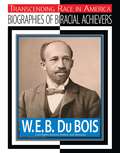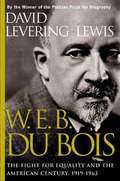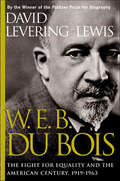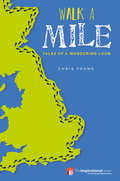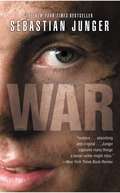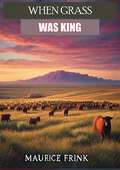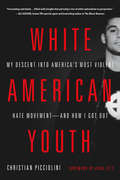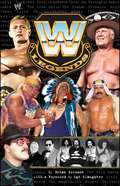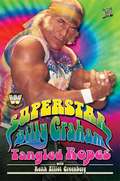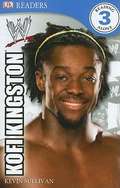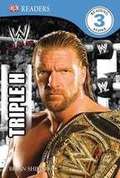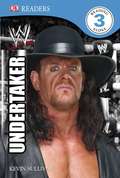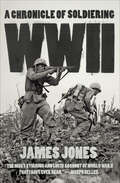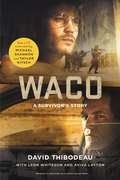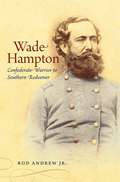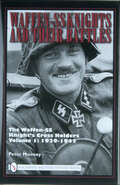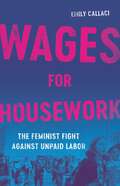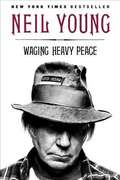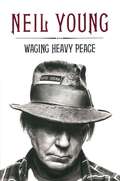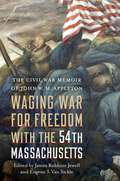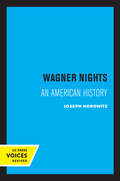- Table View
- List View
W.E.B. Du Bois: Civil Rights Activist, Author, Historian
by Jim WhitingW..E.B. Du Bois's mother came from a long line of free blacks living in the North. His great-grandfather was a white plantation owner whose ancestors came from France. Long before the start of the Civil Rights movement, W.E.B. Du Bois worked tirelessly for black people in this country. He was a brilliant student and became the first black man to receive a Ph.D. degree from Harvard University, and later taught at several black colleges. He realized that teaching wasn't enough. For decades, he wrote, gave speeches, formed organizations, and worked hard toward the cause of social justice. W.E.B. became controversial in the last years of his life. He took political positions that many Americans--both black and white--didn't approve of. But he wouldn't back down or change what he believed in. He felt so strongly about his beliefs that in his old age he moved to the African nation of Ghana, whose people loved and admired him.
W.E.B. Du Bois: The Fight for Equality and the American Century 1919-1963
by David Levering LewisThe second volume of the Pulitzer Prize--winning biography that The Washington Post hailed as "an engrossing masterpiece"<P><P> Charismatic, singularly determined, and controversial, W.E.B. Du Bois was a historian, novelist, editor, sociologist, founder of the NAACP, advocate of women's rights, and the premier architect of the Civil Rights movement. His hypnotic voice thunders out of David Levering Lewis's monumental biography like a locomotive under full steam.<P> This second volume of what is already a classic work begins with the triumphal return from WWI of African American veterans to the shattering reality of racism and lynching even as America discovers the New Negro of literature and art. In stunning detail, Lewis chronicles the little-known political agenda behind the Harlem Renaissance and Du Bois's relentless fight for equality and justice, including his steadfast refusal to allow whites to interpret the aspirations of black America. Seared by the rejection of terrified liberals and the black bourgeoisie during the Communist witch-hunts, Du Bois ended his days in uncompromising exile in newly independent Ghana. In re-creating the turbulent times in which he lived and fought, Lewis restores the inspiring and famed Du Bois to his central place in American history.<P> Pulitzer Prize Winner
W.E.B. Du Bois: The Fight for Equality and the American Century, 1919–1963
by David Levering LewisW. E. B. Du Bois, 1919-1963, the second volume of the Pulitzer Prize--winning biography that The Washington Post hailed as "an engrossing masterpiece"Charismatic, singularly determined, and controversial, W.E.B. Du Bois was a historian, novelist, editor, sociologist, founder of the NAACP, advocate of women's rights, and the premier architect of the Civil Rights movement. His hypnotic voice thunders out of David Levering Lewis's monumental biography like a locomotive under full steam.This second volume of what is already a classic work begins with the triumphal return from WWI of African American veterans to the shattering reality of racism and lynching even as America discovers the New Negro of literature and art. In stunning detail, Lewis chronicles the little-known political agenda behind the Harlem Renaissance and Du Bois's relentless fight for equality and justice, including his steadfast refusal to allow whites to interpret the aspirations of black America. Seared by the rejection of terrified liberals and the black bourgeoisie during the Communist witch-hunts, Du Bois ended his days in uncompromising exile in newly independent Ghana. In re-creating the turbulent times in which he lived and fought, Lewis restores the inspiring and famed Du Bois to his central place in American history.
WAM: Tales of a Wandering Loon (Inspirational Series)
by Chris YoungAs a kind, chatty, and good-humoured man with a zest for life and a passion for helping people, Chris Young adored his job as a social worker. But things fell apart when, in 2008, he was diagnosed with borderline personality disorder. His illness brought about the end of his calling and he found himself in need of a new project and purpose.And so it came to be that in 2011, Chris began a campaign called Walk a Mile In my Shoes. He walks around the edge of the UK – the edge of society being where many people with mental health problems feel they are – without spending any money and relying on the kindness of strangers.In 2015, he joined forces with See Me Scotland to distil the success of the coastal walk into a series of events, inviting other people to join him and discuss mental health. He encouraged them to literally walk a mile in each other's shoes. Walk a Mile: Tales of a Wandering Loon is the story of how a normal, nurturing childhood turned into one of neglect and abuse and how this, combined with a little faulty brain wiring, led to a severe and enduring mental illness.
WAR
by Sebastian JungerIn his breakout bestseller, The Perfect Storm, Sebastian Junger created "a wild ride that brilliantly captures the awesome power of the raging sea and the often futile attempts of humans to withstand it" (Los Angeles Times Book Review). Now, Junger turns his brilliant and empathetic eye to the reality of combat--the fear, the honor, and the trust among men in an extreme situation whose survival depends on their absolute commitment to one another. His on-the-ground account follows a single platoon through a 15-month tour of duty in the most dangerous outpost in Afghanistan's Korengal Valley. Through the experiences of these young men at war, he shows what it means to fight, to serve, and to face down mortal danger on a daily basis.
WHEN GRASS WAS KING Contributions to the Western Range Cattle Industry Study
by Maurice Frink W. Turrentine Jackson JacksonWhen Grass Was King by Maurice Frink offers a vivid and well-researched exploration of the early cattle industry in the American West, capturing the rise, challenges, and cultural significance of open-range ranching. Drawing on firsthand accounts, historical records, and Frink’s deep knowledge of the subject, the book provides a detailed look at the era when vast grasslands and herds of cattle defined the economic and social landscape of the western frontier.Frink traces the evolution of the cattle industry from its roots, focusing on the pioneers, cowboys, ranchers, and entrepreneurs who shaped the industry and transformed the West. He examines the dynamics of cattle drives, the establishment of vast ranches, and the creation of new markets for beef in growing cities. Through engaging narrative and insightful analysis, Frink highlights how the abundance of grasslands in the 19th century made large-scale cattle operations possible, giving rise to an iconic way of life.The book also delves into the environmental, economic, and social challenges that emerged as the industry grew. Frink discusses the impact of harsh winters, droughts, fluctuating markets, and the eventual fencing of the open range. He reflects on how these changes marked the decline of the golden era of open-range ranching, ushering in new practices that reshaped the cattle business and the Western way of life.When Grass Was King is more than a history of the cattle industry—it is a tribute to the people, landscapes, and culture that made the West legendary. Frink’s work offers readers a window into the hard work, ingenuity, and resilience required to thrive in a challenging environment.This book will appeal to those interested in American history, Western culture, or agricultural economics. Frink’s engaging storytelling and meticulous research make When Grass Was King a timeless exploration of a pivotal chapter in the history of the American West.
WHITE AMERICAN YOUTH: My Descent Into America's Most Violent Hate Movement--And How I Got Out
by Christian PiccioliniA stunning look inside the world of violent hate groups by a onetime white supremacist leader who, shaken by a personal tragedy, realized the error of his ways and abandoned his destructive life to become an anti-hate activist. As he stumbled through high school, struggling to find a community among other fans of punk rock music, Christian Picciolini was recruited by a now notorious white power skinhead leader and encouraged to fight with the movement to "protect the white race from extinction." Soon, he had become an expert in racist philosophies, a terror who roamed the neighborhood, quick to throw fists. When his mentor was arrested and sentenced to eleven years in prison, sixteen-year-old Picciolini took over the man's role as the leader of an infamous neo-Nazi skinhead group. Seduced by the power he accrued through intimidation, and swept up in the rhetoric he had adopted, Picciolini worked to grow an army of extremists. He used music as a recruitment tool, launching his own propaganda band that performed at white power rallies around the world. But slowly, as he started a family of his own and a job that for the first time brought him face to face with people from all walks of life, he began to recognize the cracks in his hateful ideology. Then a shocking loss at the hands of racial violence changed his life forever, and Picciolini realized too late the full extent of the harm he'd caused. Raw, inspiring, and heartbreakingly candid, White American Youth tells the fascinating story of how so many young people lose themselves in a culture of hatred and violence and how the criminal networks they forge terrorize and divide our nation.
WWE Legends
by Brian SolomonThey were World Heavyweight Champions: Bob Backlund, Superstar Billy Graham, and Bruno Sammartino. They were fan favorites: "Superfly" Jimmy Snuka, Chief Jay Strongbow, and Andre the Giant. They were the villains everyone loved to hate: Killer Kowalski, Ernie Ladd, and the Fabulous Moolah. They were ethnic heroes, someone just like you that you could cheer for: Ivan Putski, Pedro Morales, Peter Maivia. They were the stars that shined the brightest, and left an indelible mark on the memories of countless WWE fans.
WWE Legends - Superstar Billy Graham
by Billy Graham Keith Elliot Greenberg"I'm the man of the hour," Superstar Billy Graham told his audiences, "the man with the power. Too sweet to be sour!" Despite years of devastating health issues (a long history of drug abuse led to a liver transplant in 2002), the man regarded as one of the most influential professional wrestlers of the past thirty years still flaunts the same optimism that made his interviews as compelling as his matches. In Tangled Ropes, his autobiography, Graham remembers his victories -- and his setbacks -- on both the wrestling and the evangelism circuits in vibrant detail. At his core, Graham is still Wayne Coleman, the artistic, curious boy who escaped the wrath of his disabled father in post-war Phoenix through painting, sports, and bodybuilding. When his photo appeared in a bodybuilding magazine, the young man caught the attention of a family in Texas who began praying for his soul. Soon, Wayne found religion at a revival meeting, then mortified his parents as he left home to bend steel, rip phone books in half, and preach the Gospel on the back roads of America. Because of his natural athleticism, Wayne held a series of jobs -- from bouncer to boxer, from repo man to football player. However, it was under the training of the "Mentor of Mayhem," Stu Hart, that the wrestler was revealed. Then the fading headliner Dr. Jerry Graham bleached Wayne's hair blond and transformed him into an in-ring "brother." Still reverent of men of faith, Coleman became "Billy Graham," after the preacher. Graham completed the package with his golden tan and enormous "pythons," a succession of color-coordinated outfits and jive-talking -- a persona imitated by countless wrestlers, including Hulk Hogan and Jesse "The Body" Ventura. The Superstar's greatest wrestling achievement came in 1977, when he took the World Wide Wrestling Federation Championship from Bruno Sammartino. He held the prize for nearly a year -- the first wrestling villain to do so. But after he lost the title to wholesome Bob Backlund, Graham fell into a deep depression. He disappeared from the business, squandering his money and losing himself in a haze of drugs. In Tangled Ropes -- co-written with Keith Elliot Greenberg -- Superstar Billy Graham tells a story that transcends his life in the wrestling profession, offering candor, nostalgia, inspiration, and humor. Graham's narrative is supplemented by anecdotes from personalities like Vince McMahon, Jesse Ventura, Ivan Koloff, Ric Flair, Dusty Rhodes, and California governor Arnold Schwarzenegger.
WWE: Kofi Kingston (Reading Alone #3)
by Kevin SullivanThis book is about Kofi Kingston, a wrestler from Ghana, West Africa, who, through his unique signature moves made a mark for himself in WWE arena right from his first match in 2008.
WWE: Triple H (Reading Alone #3)
by Brian ShieldsA part of DK Readers series, this book is about a WWE wrestler Triple H, who is a twelve-time world champion: a seven-time WWE Champion, and a five-time World Heavyweight Champion.
WWE: Undertaker (Reading Alone #3)
by Kevin SullivanThis is all about the favourite WWE superstar - Undertaker, a four time WWE champion and winner of 2007 Royal Rumble.
WWII Biographies: Hitler and the Third Reich
by Catherine BradleyThe life of the German chancellor, focusing on his rise to power, the buildup of the German Wehrmacht, and his death in 1945 in a Berlin bunker.
WWII: A Chronicle of Soldiering
by James JonesThis &“unique and fascinating&” WWII memoir by the acclaimed author of From Here to Eternity and The Thin Red Line &“stands out as one of the most vivid&” (The Wall Street Journal). In 1975, James Jones was chosen to write the text for an oversized coffee table book featuring visual art from World War II. The book was a best seller, praised for both its images and for Jones&’s text. In subsequent decades, when it became impossible to reproduce the book with its original artwork, it fell out of print and was forgotten. But now, this edition of WWII makes Jones&’s stunning text—his only extended nonfiction writing on the war—available once again. Moving chronologically and thematically through the complex history of World War II, Jones interweaves his own vivid memories of soldiering in the Pacific—from the look on a Japanese fighter pilot&’s face as he bombed Pearl Harbor, so close that Jones could see him smile and wave, to hitting the beach under fire in Guadalcanal—while always returning to resounding larger themes. While much of WWII is a tribute to the commitment of American soldiers, Jones also pulls no punches when recounting questionable strategic choices, wartime suffering, disorganization, the needless loss of life, and the brutal realization that a soldier is merely a cog in a heartless machine
Wa. Woo. Cee. (Va. Woo. Chidhambaranar)
by Ma. Ra. ArasuVallinayagam Olaganthan Chidambaram Pillai, (1872-1936) popularly known by his initials, V.O.C. (spelt Wa.Woo.Cee in Tamil), was a Tamil political leader who actively took part in the freedom movement in India. He is known as Kappalottiya Tamilan (The Tamil Helmsman). In this Monograph in Tamil the author Ma. Ra. Arasu, gives an account of the life sketches of Wa. Woo. Cee., his articles and essays, translations, lectures, speeches and discourses, literary contributions, etc.
Waco: A Survivor's Story
by David Thibodeau Leon Whiteson Aviva LaytonAs a tie-in to the upcoming Paramount Network miniseries starring Michael Shannon, Taylor Kitsch, and Melissa Benoist and commemorating the 25th anniversary of the siege at Waco, comes an updated reissue of the critically acclaimed A PLACE CALLED WACO by Branch Davidian survivor, David Thibodeau.For the first time ever, a survivor of the Waco massacre tells the inside story of Branch Davidians, David Koresh, and what really happened at the religious compound in Texas. When he first met the man who called himself David Koresh, David Thibodeau was drumming for a rock band that was going nowhere fast. Intrigued and frustrated with a stalled music career, Thibodeau gradually became a follower and moved to the Branch Davidian compound in Waco, Texas. He remained there until April 19, 1993, when the compound was stormed and burnt to the ground after a 51-day standoff. In this book, Thibodeau explores why so many people came to believe that Koresh was divinely inspired. We meet the men, women, and children of Mt. Carmel. We get inside the day-to-day life of the community. Thibodeau is brutally honest about himself, Koresh, and the other members, and the result is a revelatory look at life inside a cult. But Waco is just as brutally honest when it comes to dissecting the actions of the United States government. Thibodeau marshals an array of evidence, some of it never previously revealed, and proves conclusively that it was our own government that caused the Waco tragedy, including the fires. The result is a memoir that reads like a thriller, with each page taking us closer to the eventual inferno.
Wade Hampton
by Rod AndrewOne of the South's most illustrious military leaders, Wade Hampton III was for a time the commander of all Lee's cavalry and at the end of the war was the highest-ranking Confederate cavalry officer. Yet for all Hampton's military victories, he also suffered devastating losses in his family and personal life. Rod Andrew's critical biography sheds light on his central role during Reconstruction as a conservative white leader, governor, U.S. senator, and Redeemer; his heroic image in the minds of white southerners; and his positions and apparent contradictions on race and the role of African Americans in the New South. Andrew also shows that Hampton's tragic past explains how he emerged in his own day as a larger-than-life symbol--of national reconciliation as well as southern defiance.
Waffen-SS Knights and Their Battles: The Waffen-SS Knight’s Cross Holders Vol.1: 1939-1942
by Peter MooneyFourth volume in series Covers Knight's Cross recipients January to May 1944
Waffen-SS Knights and Their Battles: The Waffen-SS Knight’s Cross Holders Volume 2: January–July 1943
by Peter MooneyFourth volume in series Covers Knight's Cross recipients January to May 1944
Wages for Housework: The Feminist Fight Against Unpaid Labor
by Emily CallaciThe &“illuminating, honest, nuanced&” (Robin D. G. Kelley) story of a radical campaign to change the way we value work Women do more than three-quarters of all the world&’s unpaid care work, contributing over $9 trillion to the global economy each year. Dishes don&’t clean themselves; dinner is not magically made; children must be cared for. But why is this work not compensated? Wages for Housework is the fascinating international story of Selma James, Silvia Federici, Mariarosa Dalla Costa, Wilmette Brown, and Margaret Prescod, whose movement demanded wages as a starting point for remaking the world as we know it. Drawing on their campaign&’s roots in 1970s America, Italy, and the UK, with original archival research and interviews, historian Emily Callaci explores the revolutionary potential of paying women for their work in the home, and how Wages for Housework reimagined potential futures under capitalism—and beyond—in ways that continue to be relevant today. Wages for Housework is an essential feminist history of an overlooked movement for economic and social justice.
Waging Heavy Peace
by Neil YoungThis beautiful limited edition will be signed by Neil Young and repackaged in a slip case and linen cover. Only 1,500 copies will be printed, making it an essential addition to every music lover’s collection. For the first time, legendary singer, songwriter, and guitarist Neil Young offers a kaleidoscopic view of his personal life and musical creativity. He tells of his childhood in Ontario, where his father instilled in him a love for the written word; his first brush with mortality when he contracted polio at the age of five; struggling to pay rent during his early days with the Squires; traveling the Canadian prairies in Mort, his 1948 Buick hearse; performing in a remote town as a polar bear prowled beneath the floorboards; leaving Canada on a whim in 1966 to pursue his musical dreams in the pot-filled boulevards and communal canyons of Los Angeles; the brief but influential life of Buffalo Springfield, which formed almost immediately after his arrival in California. He recounts their rapid rise to fame and ultimate break-up; going solo and overcoming his fear of singing alone; forming Crazy Horse and writing “Cinnamon Girl,” “Cowgirl in the Sand,” and “Down by the River” in one day while sick with the flu; joining Crosby, Stills & Nash, recording the landmark CSNY album, Déjà vu, and writing the song, “Ohio;” life at his secluded ranch in the redwoods of Northern California and the pot-filled jam sessions there; falling in love with his wife, Pegi, and the birth of his three children; and finally, finding the contemplative paradise of Hawaii. Astoundingly candid, witty, and as uncompromising and true as his music, Waging Heavy Peace is Neil Young’s journey as only he can tell it. .
Waging Heavy Peace: A Hippie Dream
by Neil YoungLegendary singer, songwriter, and guitarist Neil Young offers a kaleidoscopic view of his personal life and musical creativity. He tells of his childhood in Ontario; his first brush with mortality when he contracted polio at the age of five; struggling to pay rent during his early days; traveling the Canadian prairies; performing in a remote town; leaving Canada in 1966 to pursue his musical dreams at Los Angeles; the brief life of Buffalo Springfield after his arrival in California.
Waging War for Freedom with the 54th Massachusetts: The Civil War Memoir of John W. M. Appleton
by John W. AppletonLate in 1862, amid the horrors of the U.S. Civil War, Secretary of War Edwin Stanton, with President Lincoln&’s approval, authorized the recruitment of Black soldiers for the Union cause. In January of 1863, the 54th Massachusetts Volunteer Infantry was born. On February 7, 1863, Massachusetts governor John Andrew commissioned Boston-bred John W. M. Appleton the first of the white officers in the most famous Civil War regiment of Black soldiers. Appleton immediately began recruiting enlisted soldiers for the company he would command, Company A.Waging War for Freedom with the 54th Massachusetts is a fresh look at the service of this famed regiment as told through Appleton&’s memoir—the most complete first-person account available about the service of the men in the 54th Massachusetts regiment. Appleton wrote candidly about his own experiences and the men who served with and under him, including troop punishments, combat, and combat injuries, including his own. He also described in detail the weather, climate, southern geography, and his interaction with civilians. Appleton served with the regiment from February 1863 through August 1864, when severe injuries forced him home a second time. Taking Appleton&’s memoir as their foundation, the editors thoroughly contextualize the service of the 54th through its disbanding in 1865, providing a fresh perspective on the men and the regiment as they fought to abolish slavery in the United States.
Wagner Nights: An American History (California Studies in 19th-Century Music #9)
by Joseph HorowitzAs never before or since, Richard Wagner's name dominated American music-making at the close of the nineteenth century. Europe, too, was obsessed with Wagner, but—as Joseph Horowitz shows in this first history of Wagnerism in the United States—the American obsession was unique. The central figure in Wagner Nights is conductor Anton Seidl (1850-1898), a priestly and enigmatic personage in New York musical life. Seidl's own admirers included the women of the Brooklyn-based Seidl Society, who wore the letter "S" on their dresses. In the summers, Seidl conducted fourteen times a week at Brighton Beach, filling the three-thousand-seat music pavilion to capacity. The fact that most Wagnerites were women was a distinguishing feature of American Wagnerism and constituted a vital aspect of the fin-de-siècle ferment that anticipated the New American Woman. Drawing on the work of such cultural historians as T. Jackson Lears and Lawrence Levine, Horowitz's lively history reveals an "Americanized" Wagner never documented before. An entertaining and startling read, a treasury of operatic lore, Wagner Nights offers an unprecedented revisionist history of American culture a century ago. This title is part of UC Press's Voices Revived program, which commemorates University of California Press’s mission to seek out and cultivate the brightest minds and give them voice, reach, and impact. Drawing on a backlist dating to 1893, Voices Revived makes high-quality, peer-reviewed scholarship accessible once again using print-on-demand technology. This title was originally published in 1994.
